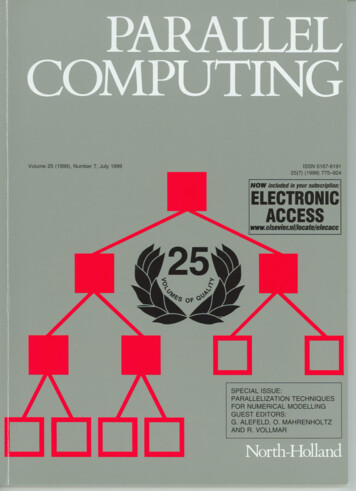
Transcription
.11RISSN 0167-8191Volume 25 (1999), Number 7, July 199925(7) (1999) 775-924INOW includedin your cate/e/ecacc11u1(25'.sOf 4jr .,11111111n.11HSPECIAL ISSUE:PARALLELlZATION TECHNIQUESFOR NUMERICAL MODELLlNGGUEST EDITORS:G. ALEFELD, O. MAHRENHOLTZAND R. VOLLMARH11' 'l1li.1111-11111.l1li 1111 ' ' '-".11:111 J
Parallel ComputingEditorial boardEditor-in-chiefG.R. JoubertF. Arbab (Amsterdam, Netherlands)V.C. Barbosa (Rio de Janeiro, Brazil)L.N. Bhuyan (College Station, USA)A.P.w. Bohm (Fort Collins, USA)M. Cosnard (Lyon, France)F. Darema (Arlington, USA)E.H. D'Hollander (Ghent, Belgium)J.J. Dongarra (Knoxville, USA)C. Farhat (Boulder, USA)PA Feautrier (Versailles, France)W. Gentzsch (Regensburg, Germany)L. Grandinetti (Rende, Italy)R. Gupta (Pittsburgh, USA)S. Hambrusch (West Lafayette, USA)M. Hamdi (Hong Kong, P.R. China)F. Hossfeld (Jülich, Germany)K. Iwama (Kyoto, Japan)HF Jordan (Boulder, USA)Y. Kaneda (Kobe, Japan)J.S. Kowalik (Seattle, USA)V. Kumar (Minneapolis, USA)K. Miura (Kawasaki, Japan)D. Müller-Wichards (Hamburg, Germany)S. Nagashima (Tokyo, Japan)Y. Oyanagi (Tokyo, Japan)D. Parkinson (Guildford, UK)N. Petkov (Groningen, Netherlands)M.J. Quinn (Corvallis, USA)A. Sameh (West Lafayette, USA)U. Trottenberg (S1. Augustin, Germany)HA Van der Vorst (Utrecht, Netherlands)R.G. Voigt (Arlington, VA, USA)R. Vollmar (Karlsruhe, Germany)D.E. Womble (Albuquerque, USA)T. Yuba (Tokyo, Japan)E.L. Zapata (Malaga, Spain)(Technical University of Clausthal)Aquariuslaan 605632 BD EindhovenThe NetherlandsManaging editorW. RönschIBM Scientific Center ISAMVangerowstraße 1869115 HeidelbergGermanyRegional editorsNorth, Central and South AmericaR. HiromotoUniversity of Texas at San AntonioDiv. Computer Science6900 North Loop 1604 WestSan Antonio, TX 78249-0667USAEurope, Africa, Middle East and AustralasiaD. TrystramLMC-IMAG46 Avenue Felix Viallet38031 Grenoble CedexFranceAsiaM. ShimasakiKyoto UniversityDep1.of Electrical EngineeringKyoto 606JapanHonorary editorU. Schendei (Berlin, Germany)Editorialpolicy. Parallel Computing is an international journal presenting the theory and use of parallel computer systems,including vector, pipeline, array, fifth and future generation computers and neural computers. Within this context the journal coversall aspects of high-speed computing.Its primary objectives are:- publication of new research results pertaining to the development and application of parallel computer systems;- dissemination of information on new developments and events in this field.The editorial policy and the technical content of the journal are the responsibility of the Editors and the Editorial board. The journalis self-supporting frarn subscription income and contains a minimum amount of advertisements. Advertisements are subject to theprior appraval of the Editors.Scope. Parallel Computingfeaturesoriginal research work, tutorial and review articles as weil as accounts on practical experiencewith and techniques for the use of parallel computers. Contributions can cover:- algorithm design for all types of parallel computers;- ensp;all aspects of the application of parallel computers, including those to AI, CAD/CAM, databases, information retrieval, etc.in industrial, business and office environments;- the impact of high-speed computation on current research, as weil as the advancement of knowledge;- software engineering aspects relating to parallel computing;- software for parallel computer systems including programming languages, operating systems, utilities, libraries, etc.;- networking technology for support of high-speed computing via centralised file servers, output servers, interactive access;- taxonomy, models and architecturals trends of parallel processing;- general hardware (architecture) concepts, new technologies enabling the realisation of such new concepts as weil as details ofcommercially available systems;performance measurement results on state-of-the-art systems;- peripheral devices for parallel (super-) computers. The paper used in this publication meets the requirements0167-8191/99of ANSI/NISOPublished 14 times a yearZ39.48-1992(Permanence of Paper).Printed in The Netherlands
Parallel Computing@ 1999 Elsevier Science B.V. All rights reserved.This journal and the individual contributions contained in it are protected under copyright ofElsevier Science B.V., andthe following tenns and conditions apply to their use:PhotocopyingSingle photocopies of single articles may be made for personal use as allowed by national copyright laws. Permission ofthe publisher and payment of a fee is required for all other photocopying, including multiple or systematic copying,copying for advertising or promotional purposes, resale, and all fonns of document delivery. Special rates are availablefor educational institutions that wish to make photocopies for non-profit educational classroom use.Pennissions may be sought direcHy from Elsevier Science Rights & Pennissions Department, PO Box 800, Oxford OX5IDX, UK; phone: ( 44) 1865 843830, fax: ( 44) 1865 853333, e-mail: pennissions@elsevier.co.uk. You mayaisocontact Rights & Permissions direcHy through Elsevier's horne page (http://www.e1sevier.nl).se1ecting first 'CustomerSupport', then 'General Infonnation', then 'Permissions Query Fonn'.In the USA, users may clear pennissions and make payments through the Copyright Clearance Center, Inc., 222Rosewood Drive, Danvers, MA 01923, USA; phone: (978) 7508400, fax: (978) 7504744, and in the UK through theCopyright Licensing Agency Rapid Clearance Service (CLARCS), 90 Tottenham Court Road, London WIP OLP, UK;phone: ( 44) 171 631 5555; fax: ( 44) 171 631 5500. Other countries may have a local reprographic rights agency forpayments.Derivative WorksSubscribers may reproduce tables of contents or prepare lists of articles including abstracts for internal circulationwithin their institutions. Pennission of the publisher is required for resale or distribution outside the institution.Pennission of the publisher is required for all other derivative works, including compilations and translations.Electronic Storage or UsagePennission of the publisher is required to store or use electronically any material contained in this journal, includingany article or part of an artic1e.Except as outlined above, no part of this publication may be reproduced, stored in a retrieval system or transmitted inany fonn or by any means, e1ectronic, mechanical, photocopying, recording or otherwise, without prior writtenpennission of the publisher.Address permissions requests to: Elsevier Science Rights & Pennissions Department,addresses no ted above.at the mail, fax and e-mailNoticeNo responsibility is assumed by the Publisher for any injury and/or damage to persons or property as a matter ofproducts liability, negligence or otherwise, or from any use or operation of any methods, products, instructions or ideascontained in the material herein. Because of rapid advances in the medical sciences, in particular, independentverification of diagnoses and drug dosages should be made.Although all advertising material is expected to confrom to ethical (medical) standards, inclusion in this publicationdoes not constitute a guarantee or endorsement of the quality or value of such product or of the claims made of it by itsmanufacturer.
Parallel ComputingAdvertising information: Advertising orders and enquiries can be sent to: USA, Canada and South America: Mr Tino deCarlo, The Advertising Department, Elsevier Science Inc., 655 Avenue of the Americas, New York, NY 10010-5107,USA; phone: ( 1) (212) 633 3815; fax: ( 1) (212) 633 3820; e-mail: t.decarlo@e1sevieLcom. Japan: The AdvertisingDepartment, Elsevier Science K.K., 9-15 Higashi-Azabu 1-chome, Minato-ku, Tokyo 106-0044, Japan; phone: ( 81)(3) 5561 5033; fax: ( 81) (3) 5561 5047. Europe and ROW: Rachel Gres1e-Farthing, The Advertising Department,E1sevier Science Ltd., The Boulevard, Langford Lane, Kidlinton, Oxford OX5 1GB, UK; phone: ( 44) (1865) 843565;fax: ( 44) (1865) 843976; e-mail: Lgres1e-farthing@elsevier.co.ukOrders, claims and product enquiries: please contact the Customer Support Deportment at the Regional Sa1es Officenearest you:New York: Elsevier Science, PO Box 945, New York, NY 10159-0945, USA; phone: ( 1) (212) 633 3730 [toll freenumber for North American customers: 1-888-4ES-INFO (437-4636)]; fax: ( 1) (212) 633 3680; e-mail: usinfof@elsevieLcomAmsterdam: Elsevier Science, PO Box 211,1000 AE Amsterdam, The Nether1ands; phone: ( 31) 20 4853757; fax: ( 31)20 4853432; e-mail: n1info-f@e1sevieLn1Tokyo: Elsevier Science, 9-15 Higashi-Azabu 1-chome, Minato-ku, Tokyo 106-0044, Japan; phone: ( 81) (3) 5561 5033;fax: ( 81) (3) 5561 5047; e-mail: info@e1sevier.co.jpSingapore: Elsevier Science, No. 1 Temasek Avenue, #17-01 Millenia Tower, Singafore 039192; phone: ( 65) 434 3727;fax: ( 65) 337 2230; e-mail: asiainfo@elsevier.com.sgRio de Janeiro: Elsevier Science,Rua Sete de Setembro 111116Andar, 20050-002Centro, Rio de Janeiro - RJ, Brazi1;phone: ( 55) (21) 509 5340; fax: ( 55) (21) 507 1991; e-mail: elsevier@campus.com.br [Note (Latin America): fororders, claims and help desk information, pIese contact the Regional Sa1es Office in Newyork as listed above]e The paperused in this publication meets the requirements of ANSIINISO Z39.48-1992 (Permanence of Paper)Welcome to OASISOn-line Article Status Information SystemIntroductionAuthors of articles which are currently in production at Elsevier can obtain the following information on the status oftheir article:.General production status (in preparation, in proof, in issue)Date of pub1ication and offprints dispatch dateIssue, vo1ume and page numberHow to get information about the status of your articleFor privacy, information on your article is password-protected. You need to key in 'Our Reference' code, which is inour acknow1edgement letter) and the name of the corresponding author.How to get supportIn case of problems with obtaining the information ab out your article, please contact authorsupport@elsevier.nl.Kind1y mention the title of your article and the journal.
Special issue: Parallelization techniques for numerical modellingGuest editors: G. Alefeld, O. Mahrenholtz and R. VollmarCONTENTSGuest editorialG. Alefeld, O. Mahrenholtz and R. VollmarParallelization techniques for numerical modelling775Special papersG. AdrianParallel processing in regional climatology: The parallel version of the"Karlsruhe Atmospheric Mesoscale Model" (KAMM)777R. Diekmann, A. Frommer and B. MonienEfficient schemes for nearest neighbor load balancing789R. Ebner and C. ZengerA distributed functional framework for recursive finite element simulations813M. Griebel and G. ZumbuschParallel multigrid in an adaptive PDE solver based on hashing and space-filling curves 827B. LangEfficient eigenvalueand singularvalue computationson shared memorymachines845I. Lenhardt and T. RottnerKrylov subspace methods for structural finite element analysis861T. LippertHyper-systolicalgorithmsfor N-bodycomputationsand parallellevel-3 BLAS libraries .877W. Mackens and H. VossGeneral masters in parallel condensation of eigenvalue problems893R. MöllerA systolic implementationof the MLEM reconstructionalgorithmfor lendar of forthcoming conferences and events921
IELSEVIERPARALLELCOMPUTINGParallel Computing 25 (1999) 775-776www.elsevier.com/locate/parcoGuest editorialParallelization techniques for numericalmodellingThis volume contains aselection of papers which were presented during a Dagstuhl Seminar in the Internationales Begegnungs-und Forschungszentrum für Informatik at Dagstuhl Castle. The tide of the Seminar was "Parallel Processing in theEngineering Sciences - Methods and Applications". Parallel computers are meanwhile a generally accepted tool in all parts of applied scientific research. Unfortunately the speed up of algorithms is in practice often not as huge as theoreticallyawaited.The intention of the seminar was to bring together scientists from the field ofNumerical Analysis, Computer Science, Engineering and Natural Science, respectively, in order to discuss the state of the art and future developments of parallelprocessing in the applied sciences. The meeting provided a forum of exchange between these different research fields.In 24 talks various parallel algorithms for different computer architectures andparallel software for mathematical modeling of reallife problems were presented.Due to the variety of attacked problems and to the many different existing parallelcomputers no uniform methodology has evolved during the last years. Thereforedifferent methods have to be used for concrete problems. This will also be demonstrated by nearly all the papers of this volume.For example, in contrast to standard finite' element methods, the recursive substructuring technique assembles the element matrices recursively in several levels.For automated parallelization the method is using functional programming. Adaptivity requires dynamic load balancing.Adaptivity of multigrid methods for partial differential equations can be attachedby the concept of hash-table storage techniques.The efficient eigenvalue and singular value computation on shared memory machines is described by two different techniques depending on the information that isrequired.Nonlinear problems from structural finite element analysis usually are tackledwith Newton-like methods. For a parallel implementation domain decompositionmethods are used.Hyper-systolic algorithms represent a new dass of parallel computing structures.Their application to N-body computations and distributed matrix multiplication isdiscussed.0167-8191/99/ - see front matter @ 1999 Elsevier Science B.v. All rights reserved.PlI: SOl 6 7 - 8 19 1 ( 9 9 ) 0 0 0 3 4 - 4Co
776Guest editorial! Parallel Computing 25 (1999) 775-776In the dynamic analysis of structures using finite element methods very oftenprohibitively many degrees of freedom are required to model the structure sufficiently accurate. General masters are used in parallel condensation of eigenvalueproblems for treating this subject.For positron emission tomography images a systolic implementation of themaximum-likelihood expectation-maximum algorithm is discussed.This issue contains in alphabetic order the papers which are (with one exception)concentrated on parallel processing with special emphasis on numerical methods. ,Allpapers were refereed anonymously. The editors are grateful to the referees for theirvery valuable support.The organizers express their thanks to the administration and to the staff ofDagstuhl Castle for the pleasant atmosphere and to the contributors to this issue.They also thank Professor Joubert and Dr. Rönsch for publishing the articles in"Parallel Computing".G. Alefeld,KarlsruheO. Mahrenholtz, HamburgR. Vollmar,Karlsruhe
T. Yuba (Tokyo, Japan) E.L. Zapata (Malaga, Spain) Editor-in-chief G.R. Joubert (Technical University of Clausthal) Aquariuslaan 60 5632 BD Eindhoven The Netherlands Managing editor W. Rönsch IBM Scientific Center ISAM Vangerowstraße 18 69115 Heidelberg Germany Regional editors North, Central and South America R. Hiromoto University of Texas .
